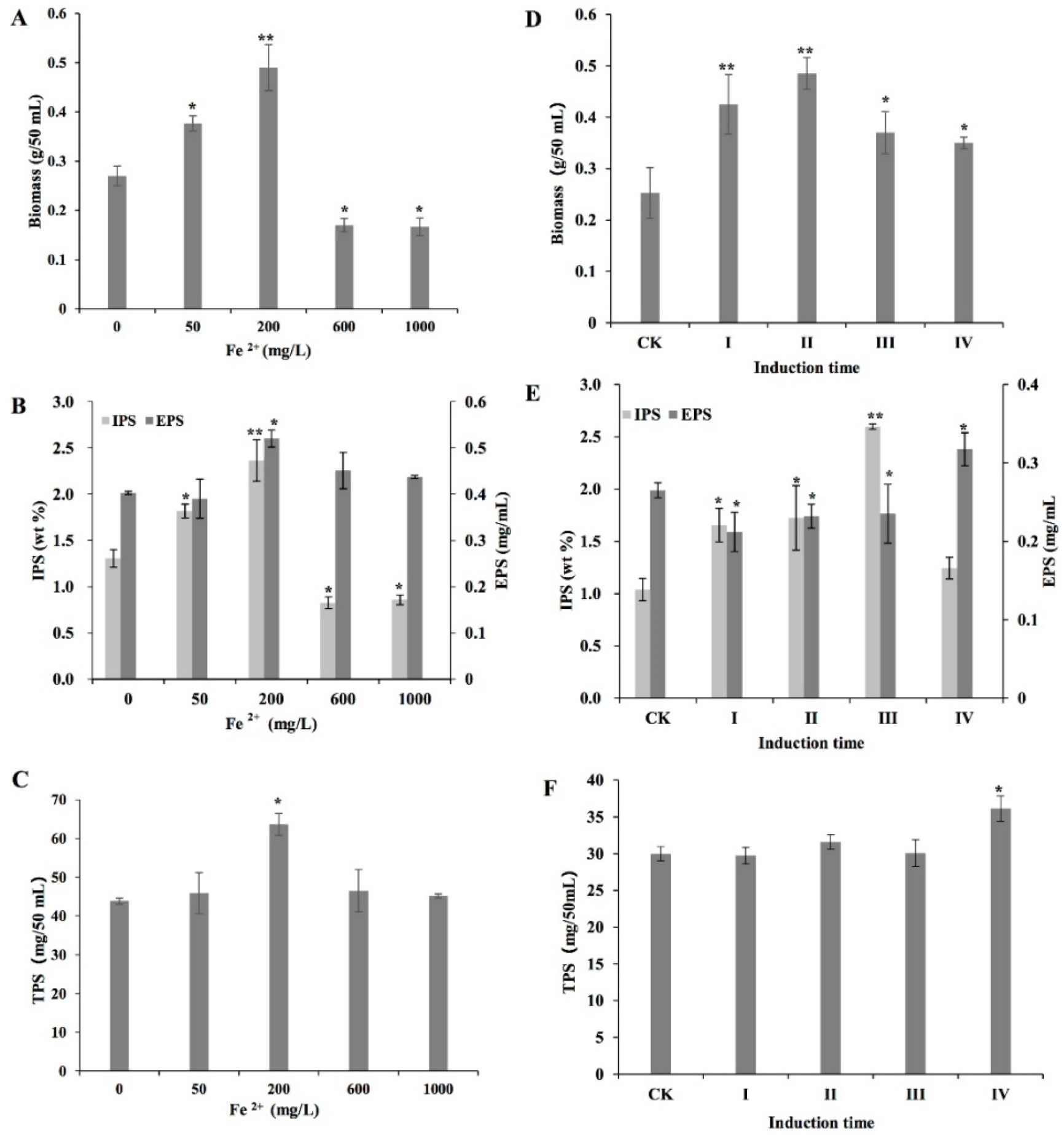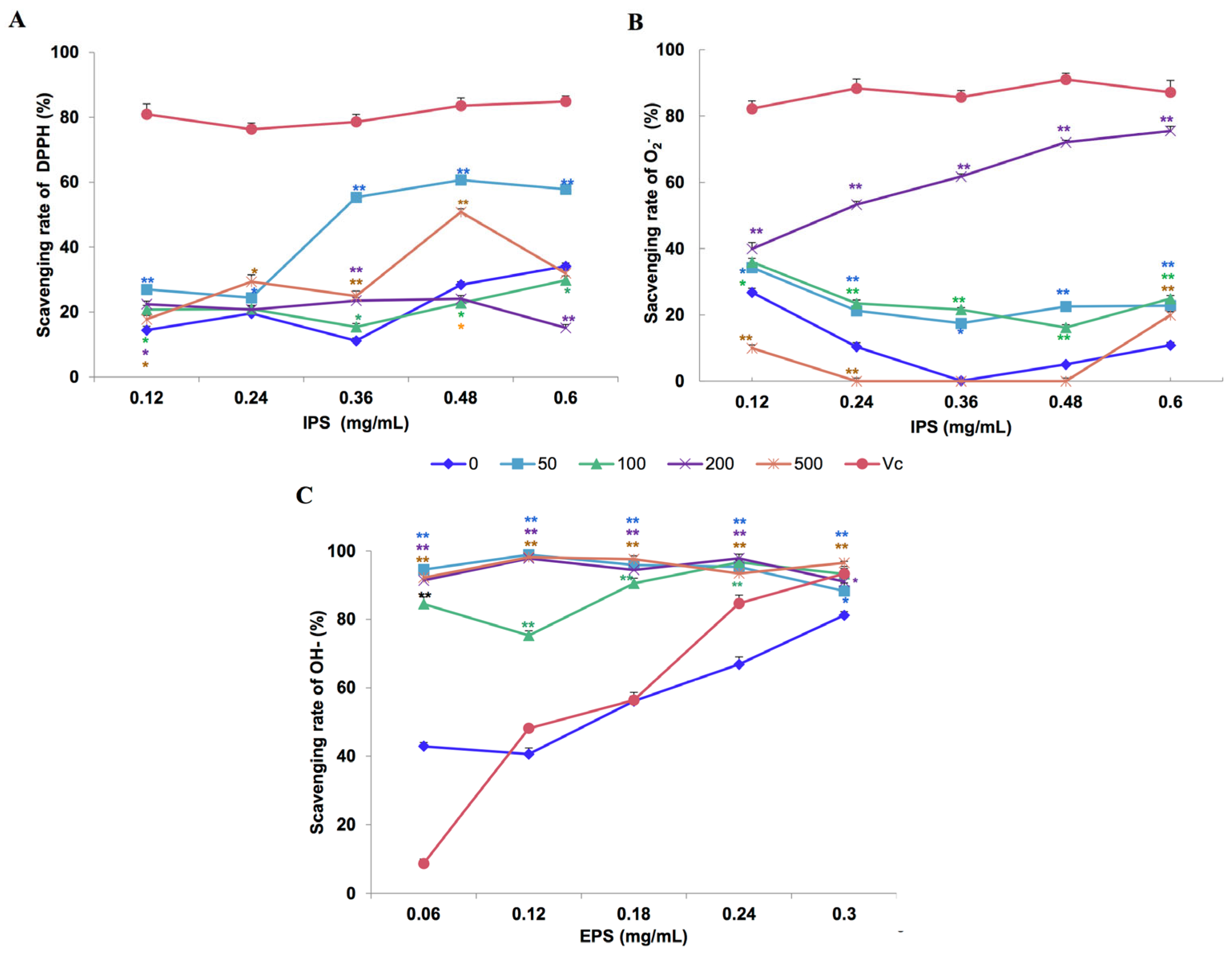Enhanced Effects of Iron on Mycelial Growth, Metabolism and In Vitro Antioxidant Activity of Polysaccharides from Lentinula edodes
Abstract
:1. Introduction
2. Materials and Methods
2.1. Fungal Strain and Culture Conditions
2.2. Assessment of Optimal Fe2+ Concentration and Induction Time
2.3. Biomass and Polysaccharides Determination
2.4. Dynamic Changes in Biomass and Polysaccharides Production
2.5. Effects of Fe 2+ on Polysaccharide Synthesis
2.5.1. Enzyme Activity Assays
2.5.2. Transcriptional Expression Analysis
2.6. In Vitro Antioxidant Activities of Polysaccharides
2.7. Statistical Analysis
3. Results
3.1. Assessment of Optimal Fe2+ Concentration and Induction Time
3.2. Dynamic Changes in the Mycelial Biomass and Polysaccharides Production
3.3. Effects of Fe2+ on Polysaccharide Synthesis
3.3.1. Enzyme Activity Assays
3.3.2. Transcriptional Expression Analysis
3.4. Effect of Fe2+ on the In Vitro Antioxidant Activity of Polysaccharides
4. Discussion
5. Conclusions
Author Contributions
Funding
Institutional Review Board Statement
Informed Consent Statement
Data Availability Statement
Conflicts of Interest
References
- Matsuoka, H.; Seo, Y.; Wakasugi, H.; Saito, T.; Tomoda, H.M. Lentinan potentiates immunity and prolongs the survival time of some patients. Anticancer Res. 1997, 17, 2751–2755. [Google Scholar] [PubMed]
- Mizono, M.; Minato, K.I.; Tsuchida, H. Preparation and specificity of antibodies to an anti-tumor β-glucan, lentinan. Iubmb. Life 2010, 39, 679–685. [Google Scholar] [CrossRef] [PubMed]
- Chihara, G.; Hamuro, J.; Maeda, Y.; Arai, Y.; Fukuoka, F. Fractionation and purification of the polysaccharides with marked antitumor activity, especially lentinan, from Lentinus edodes (Berk.) Sing. (an edible mushroom). Cancer Res. 1970, 30, 2776–2781. [Google Scholar] [CrossRef] [PubMed]
- Zhang, Y.Y.; Li, S.; Wang, X.H.; Zhang, L.N. Advances in lentinan: Isolation, structure, chain conformation and bioactivities. Food Hydrocoll. 2011, 25, 196–206. [Google Scholar] [CrossRef]
- Zi, Y.S.; Zhang, B.; Jiang, B.; Yang, X.Y.; Liang, Z.L.; Liu, W.Y.; He, C.F.; Liu, L. Antioxidant action and protective and reparative effects of lentinan on oxidative damage in HaCaT cells. J. Cosmet. Derm. 2018, 17, 1108–1114. [Google Scholar] [CrossRef]
- Atila, F. Medicinal Plants; Springer: Cham, Switzerland, 2021; pp. 383–413. [Google Scholar] [CrossRef]
- Gu, F.H.; Yin, H.; Ma, J. Influences of different carbon and nitrogen sources on mycelial growth and extracellular polysaccharide yields of Polyporus umbellatus. J. Northwest Univ. 2001, 5, 437–440. [Google Scholar] [CrossRef]
- Shih, I.; Chang, S.; Chen, Y. Cultivation of Cordyceps Militaris in solid and liquid culture. J. Am. Diet. Assoc. 2010, 110, A51. [Google Scholar] [CrossRef]
- Zhu, Z.Y.; Liu, X.C.; Dong, F.Y.; Guo, M.Z.; Wang, X.T.; Wang, Z.; Zhang, Y.M. Influence of fermentation conditions on polysaccharide production and the activities of enzymes involved in the polysaccharide synthesis of Cordyceps. militaris. Appl. Microbiol. Biot. 2016, 100, 3909–3921. [Google Scholar] [CrossRef]
- Adil, B.; Xiang, Q.J.; He, M.L.; Wu, Y.T.; Asghar, M.A.; Arshad, M.; Gu, Y.F.; Yu, X.M.; Zhao, K.; Zhang, X.P.; et al. Effect of sodium and calcium on polysaccharide production and the activities of enzymes involved in the polysaccharide synthesis of Lentinus. edodes. AMB Express 2020, 10, 47. [Google Scholar] [CrossRef]
- Lu, H.Y.; Liu, S.Y.; Zhang, S.L.; Chen, Q.H. Light irradiation coupled with exogenous metal ions to enhance exopolysaccharide synthesis from Agaricus sinodeliciosus ZJU-TP-08 in liquid fermentation. J. Fungi. 2021, 7, 992. [Google Scholar] [CrossRef]
- Chen, R.Z.; Meng, F.L.; Liu, Z.Q.; Chen, R.P.; Zhang, M. Antitumor activities of different fractions of polysaccharide purified from Ornithogalum. caudatum. Ait. Carbohyd. Polym. 2010, 80, 845–851. [Google Scholar] [CrossRef]
- Ferreira, S.S.; Passos, C.P.; Madureira, P.; Vilanova, M.; Coimbra, M.A. Structure-function relationships of immunostimulatory polysaccharides: A review. Carbohyd. Polym. 2015, 132, 378–396. [Google Scholar] [CrossRef]
- Kaleta, B.; Górski, A.; Zagożdżon, R.; Cieślak, M.; Kaźmierczak-Barańskad, J.; Nawrot, B.; Klimaszewskaa, M.; Malinowskaa, E.; Górskaa, S.; Turłoa, J. Selenium-containing polysaccharides from Lentinula edodes—Biological activity. Carbohyd. Polym. 2019, 223, 115078. [Google Scholar] [CrossRef]
- Górska-Jakubowska, S.; Klimaszewska, M.; Podsadni, P.; Kaleta, B.; Zagożdżon, R.; Górska, S.; Gamian, A.; Tomasz Strączek, T.; Kapusta, C.; Cieślak, M.; et al. Selenium-containing exopolysaccharides isolated from the culture medium of Lentinula edodes: Structure and biological activity. Int. J. Mol. Sci. 2021, 22, 13039. [Google Scholar] [CrossRef]
- Zhang, M.; Cui, S.W.; Cheung, P.C.; Wang, Q. Antitumor polysaccharides from mushrooms: A review on their isolation process, structural characteristics and antitumor activity. Trends Food Sci. Tech. 2007, 18, 4–19. [Google Scholar] [CrossRef]
- Kaleta, B.; Roszczyk, A.; Zych, M.; Kniotek, M.; Radosaw, Z.; Marzenna, K.; Eliza, M.; Micha, P.; Turo, J. Selective biological effects of selenium-enriched polysaccharide (se-le-30) isolated from Lentinula edodes mycelium on human immune cells. Biomolecules 2021, 11, 1777. [Google Scholar] [CrossRef]
- Sun, H.Q.; Zhu, Z.Y.; Tang, Y.L.; Ren, Y.Y.; Song, Q.Y.; Tang, Y.; Zhang, Y.M. Structural characterization and antitumor activity of a novel Se-polysaccharide from selenium-enriched Cordyceps gunnii. Food Funct. 2018, 9, 2744–2754. [Google Scholar] [CrossRef]
- Englander, C.M.; Corden, M.E. Stimulation of mycelial growth of endothia parasitica by heavy metals. J. Appl. Microbiol. 1971, 22, 1012–1016. [Google Scholar] [CrossRef]
- Liu, T.; Liu, T.T.; Liu, H.C.; Fan, H.X.; Chen, B.Y.; Wang, D.W.; Zhang, Y.R.; Sun, F.J. Preparation and characterization of a novel polysaccharide-iron(iii) complex in Auricularia auricula potentially used as an iron supplement. Biomed. Res. Int. 2019, 2019, 6416941. [Google Scholar] [CrossRef]
- Cheng, C.; Huang, D.C.; Zhao, L.Y.; Cao, C.J.; Chen, G.T. Preparation and in vitro absorption studies of a novel polysaccharide-iron (III) complex from Flammulina velutipes. Int. J. Biol. Macromol. 2019, 132, 801–810. [Google Scholar] [CrossRef]
- Tang, Y.J.; Zhang, W.; Zhong, J.J. Performance analyses of a pH-shift and DOT-shift integrated fed-batch fermentation process for the production of ganoderic acid and ganoderma polysaccharides by medicinal mushroom Ganoderma. lucidum. Bioresour. Technol. 2009, 100, 1852–1859. [Google Scholar] [CrossRef]
- Xiang, Q.J.; Li, J.; Qin, P.; He, M.L.; Yu, X.M.; Zhao, K.; Zhang, X.P.; Ma, M.G.; Chen, Q.; Chen, X.Q.; et al. Identification and evaluation of reference genes for qRT-PCR studies in Lentinula edodes. PLoS ONE 2018, 13, e0190226. [Google Scholar] [CrossRef] [Green Version]
- Chen, A.Q.; He, S.; Li, F.F.; Li, Z.; Ding, M.Q.; Liu, Q.P.; Rong, J.K. Analyses of the sucrose synthase gene family in cotton: Structure, phylogeny and expression patterns. BMC Plant Biol. 2012, 12, 85. [Google Scholar] [CrossRef] [Green Version]
- Velázquez, E.; Tournier, H.; Buschiazzo, P.; Saavedra, G.; Schinella, G. Antioxidant activity of paraguayan plant extracts. Fitoterapia 2003, 74, 91–97. [Google Scholar] [CrossRef]
- Hobbs, C.H. Medicinal value of Lentinus edodes (Berk.) Sing. A literature review. Int. J. Med. Mushrooms 2000, 2, 287. [Google Scholar] [CrossRef]
- Adeeyo, A.O.; Lateef, A.; Gueguim-Kana, E.B. Optimization of the production of extracellular polysaccharide from the shiitake medicinal mushroom Lentinus edodes (Agaricomycetes) using mutation and a genetic algorithmcoupled artificial neural network (GA-ANN). Int. J. Med. Mushrooms 2016, 18, 571–581. [Google Scholar] [CrossRef]
- Feng, Y.L.; Li, W.Q.; Wu, X.Q.; Cheng, J.W.; Ma, S.Y. Statistical optimization of media for mycelial growth and exo-polysaccharide production by Lentinus edodes and a kinetic model study of two growth morphologies. Biochem. Eng. J. 2010, 49, 104–112. [Google Scholar] [CrossRef]
- Brauer, D.; Kimmons, T.; Phillips, M. Effects of management on the yield and high-molecular-weight polysaccharide content of shiitake (Lentinula edodes) mushrooms. J. Agr. Sci. Food Chem. 2002, 50, 5333–5337. [Google Scholar] [CrossRef] [PubMed]
- Xu, Y.N.; Zhong, J.J. Impacts of calcium signal transduction on the fermentation production of antitumor ganoderic acids by medicinal mushroom Ganoderma lucidum. Biotechnol. Adv. 2012, 30, 1301–1308. [Google Scholar] [CrossRef] [PubMed]
- Xu, Y.N.; Xia, X.X.; Zhong, J.J. Induced effect of Na(+) on ganoderic acid biosynthesis in static liquid culture of Ganoderma lucidum via calcineurin signal transduction. Biotechnol. Bioeng. 2013, 110, 1913–1923. [Google Scholar] [CrossRef] [PubMed]
- Xu, Y.N.; Xia, X.X.; Zhong, J.J. Induction of ganoderic acid biosynthesis by Mn2+ in static liquid cultivation of Ganoderma lucidum. Biotechnol. Bioeng. 2015, 111, 2358–2365. [Google Scholar] [CrossRef]
- Wen, L.; Jia, Z.H. Effect of some trace elements and vitamins on contents of polysaccharide and acid of Ganoderma lucidum. J. Anhui Agric. Sci. 2009, 37, 2041–2043. [Google Scholar] [CrossRef]
- Wang, Y.F.; Li, Y.F.; Liu, Y.Y.; Chen, X.Q.; Wei, X.L. Extraction, characterization and antioxidant activities of Se-enriched tea polysaccharides. Int. J. Biol. Macromol. 2015, 77, 76–84. [Google Scholar] [CrossRef]
- Elisashvili, V.; Wasser, S.P.; Tan, K.K.; Chichua, D.; Kachlishvili, E. Extracellular polysaccharide production by culinary-medicinal shiitake mushroom Lentinus Edodes (Berk.) singer and Pleurotus (Fr.) P. Karst. species depending on carbon and nitrogen source. Int. J. Med. Mushr. 2004, 6, 165–172. [Google Scholar] [CrossRef]
- Li, M.; Tian, Y.B.; Yan, W. The effect of metal ions on the mycelia growth and extracellular polysaccharide production of Tricholoma mongolicum. Edible. Fungi. China 2011, 30, 32–34. [Google Scholar] [CrossRef]
- Jiang, L.; Wu, S.; Jin, M.K. Effect of different nitrogen sources on activities of UDPG-pyrophosphorylase involved in pullulan synthesis and pullulan production by Aureobasidium pullulans. Carbohyd. Polym. 2011, 86, 1085–1088. [Google Scholar] [CrossRef]
- Degeest, B.; Vuyst, L.D. Correlation of activities of the enzymes a-phosphogluco- mutase, UDP-galactose 4-epimerase, and UDP-glucose pyrophosphorylase with exopolysaccharide biosynthesis by Streptococcus. thermophilus LY. Appl. Environ. Microb. 2010, 8, 3519–3527. [Google Scholar] [CrossRef]
- Li, X.B.; Jiang, F.C.; Liu, M.Y.; Qu, Y.; Lan, Z.Q.; Dai, X.L.; Huang, C.; Yue, X.; Zhao, S.Y.; Pan, X.L.; et al. Synthesis, characterization, and bioactivities of polysaccharide metal complexes: A review. J. Agr. Food Chem. 2022, 23, 6922–6942. [Google Scholar] [CrossRef]
- Turło, J.; Gutkowska, B.; Herold, F. Effect of selenium enrichment on antioxidant activities and chemical composition of Lentinula edodes (Berk.) Pegl. mycelial extracts. Food Chem. Toxicol. 2010, 48, 1085–1091. [Google Scholar] [CrossRef]






| PGI | PGM | UGP | |
|---|---|---|---|
| IPS | −0.262 | 0.867 ** | 0.869 ** |
| EPS | −0.385 | 0.177 | 0.379 |
Publisher’s Note: MDPI stays neutral with regard to jurisdictional claims in published maps and institutional affiliations. |
© 2022 by the authors. Licensee MDPI, Basel, Switzerland. This article is an open access article distributed under the terms and conditions of the Creative Commons Attribution (CC BY) license (https://creativecommons.org/licenses/by/4.0/).
Share and Cite
Xiang, Q.; Zhang, H.; Chen, X.; Hou, S.; Gu, Y.; Yu, X.; Zhao, K.; Zhang, X.; Ma, M.; Chen, Q.; et al. Enhanced Effects of Iron on Mycelial Growth, Metabolism and In Vitro Antioxidant Activity of Polysaccharides from Lentinula edodes. Bioengineering 2022, 9, 581. https://doi.org/10.3390/bioengineering9100581
Xiang Q, Zhang H, Chen X, Hou S, Gu Y, Yu X, Zhao K, Zhang X, Ma M, Chen Q, et al. Enhanced Effects of Iron on Mycelial Growth, Metabolism and In Vitro Antioxidant Activity of Polysaccharides from Lentinula edodes. Bioengineering. 2022; 9(10):581. https://doi.org/10.3390/bioengineering9100581
Chicago/Turabian StyleXiang, Quanju, Huijuan Zhang, Xiaoqian Chen, Shiyao Hou, Yunfu Gu, Xiumei Yu, Ke Zhao, Xiaoping Zhang, Menggen Ma, Qiang Chen, and et al. 2022. "Enhanced Effects of Iron on Mycelial Growth, Metabolism and In Vitro Antioxidant Activity of Polysaccharides from Lentinula edodes" Bioengineering 9, no. 10: 581. https://doi.org/10.3390/bioengineering9100581
APA StyleXiang, Q., Zhang, H., Chen, X., Hou, S., Gu, Y., Yu, X., Zhao, K., Zhang, X., Ma, M., Chen, Q., Petri, P., & Chen, X. (2022). Enhanced Effects of Iron on Mycelial Growth, Metabolism and In Vitro Antioxidant Activity of Polysaccharides from Lentinula edodes. Bioengineering, 9(10), 581. https://doi.org/10.3390/bioengineering9100581








